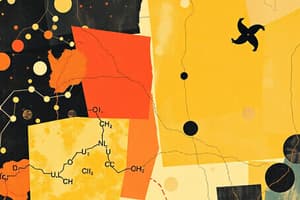Podcast
Questions and Answers
What characteristic primarily defines lipids?
What characteristic primarily defines lipids?
- Formation of peptide bonds
- Presence of amino acids
- High solubility in water
- High solubility in nonpolar solvents (correct)
Which of the following classifications of lipids includes molecules that contain isoprene units?
Which of the following classifications of lipids includes molecules that contain isoprene units?
- Phospholipids
- Triacylglycerols
- Isoprenoids (correct)
- Fatty acids
What type of fatty acid has only single carbon-carbon bonds?
What type of fatty acid has only single carbon-carbon bonds?
- Polyunsaturated
- Saturated (correct)
- Trans
- Monounsaturated
What is the melting point of arachidonic acid?
What is the melting point of arachidonic acid?
What structural feature allows lipid membranes to act as effective barriers to polar molecules?
What structural feature allows lipid membranes to act as effective barriers to polar molecules?
Which fatty acid is essential and must be obtained from the diet?
Which fatty acid is essential and must be obtained from the diet?
How many carbon atoms do most naturally occurring fatty acids have?
How many carbon atoms do most naturally occurring fatty acids have?
Which of the following fatty acids is considered saturated?
Which of the following fatty acids is considered saturated?
Which term describes fatty acids that have one or more double bonds in their hydrocarbon chain?
Which term describes fatty acids that have one or more double bonds in their hydrocarbon chain?
Which unsaturated fatty acid is the most common in nature?
Which unsaturated fatty acid is the most common in nature?
What is produced during the hydrolysis of triglycerols in a process called saponification?
What is produced during the hydrolysis of triglycerols in a process called saponification?
Which fatty acid has the highest melting point among those listed?
Which fatty acid has the highest melting point among those listed?
What distinguishes monounsaturated fatty acids from polyunsaturated fatty acids?
What distinguishes monounsaturated fatty acids from polyunsaturated fatty acids?
What are triacylglycerols primarily used for in animals?
What are triacylglycerols primarily used for in animals?
Among the following, which characteristic is not typical of unsaturated fatty acids?
Among the following, which characteristic is not typical of unsaturated fatty acids?
Which of the following describes branched-chain fatty acids found in microorganisms?
Which of the following describes branched-chain fatty acids found in microorganisms?
What is the primary historical use of soap during the time of Hippocrates?
What is the primary historical use of soap during the time of Hippocrates?
Which of the following describes a phosphoglyceride?
Which of the following describes a phosphoglyceride?
Which lipid is described as commonly found in biological membranes and is rich in highly reduced carbons?
Which lipid is described as commonly found in biological membranes and is rich in highly reduced carbons?
What is the correct interpretation of glycerophospholipid nomenclature?
What is the correct interpretation of glycerophospholipid nomenclature?
What is cardiolipin primarily known for?
What is cardiolipin primarily known for?
What is a notable feature of phosphatidic acid?
What is a notable feature of phosphatidic acid?
Which of the following BEST describes sphingolipids?
Which of the following BEST describes sphingolipids?
What contributes to the energy yield difference between triacylglycerols and carbohydrates?
What contributes to the energy yield difference between triacylglycerols and carbohydrates?
What forms the backbone of glycosphingolipids?
What forms the backbone of glycosphingolipids?
What characterizes a cerebroside in glycosphingolipids?
What characterizes a cerebroside in glycosphingolipids?
What happens when a sulfate is esterified at the 3-position of galactose?
What happens when a sulfate is esterified at the 3-position of galactose?
What role do gangliosides play in the body?
What role do gangliosides play in the body?
What is the primary feature of waxes?
What is the primary feature of waxes?
Which type of terpene consists of four isoprene units?
Which type of terpene consists of four isoprene units?
Why are waxes generally water-insoluble?
Why are waxes generally water-insoluble?
What incorrect statement could be made about monoterpenes?
What incorrect statement could be made about monoterpenes?
Flashcards
Lipids: Definition
Lipids: Definition
Lipids are biological molecules that are poorly soluble in water but highly soluble in nonpolar solvents, typically made of hydrocarbons.
Fatty Acid Structure
Fatty Acid Structure
A fatty acid consists of a long hydrocarbon chain (tail) with a carboxyl group (head).
Saturated vs. Unsaturated Fatty Acids
Saturated vs. Unsaturated Fatty Acids
Saturated fatty acids have only single bonds between carbon atoms, while unsaturated fatty acids have one or more double bonds.
Fatty Acid Naming
Fatty Acid Naming
Signup and view all the flashcards
Triacylglycerols
Triacylglycerols
Signup and view all the flashcards
Amphipathic Lipids
Amphipathic Lipids
Signup and view all the flashcards
Isoprenoids
Isoprenoids
Signup and view all the flashcards
Lipid Solubility
Lipid Solubility
Signup and view all the flashcards
Saturated Fatty Acids
Saturated Fatty Acids
Signup and view all the flashcards
Unsaturated Fatty Acids
Unsaturated Fatty Acids
Signup and view all the flashcards
Essential Fatty Acids
Essential Fatty Acids
Signup and view all the flashcards
Triglycerides
Triglycerides
Signup and view all the flashcards
Simple Triglyceride
Simple Triglyceride
Signup and view all the flashcards
Mixed Triglyceride
Mixed Triglyceride
Signup and view all the flashcards
Saponification
Saponification
Signup and view all the flashcards
Adipose tissue
Adipose tissue
Signup and view all the flashcards
What is soap?
What is soap?
Signup and view all the flashcards
What is a glycerophospholipid?
What is a glycerophospholipid?
Signup and view all the flashcards
What is the function of glycerophospholipids?
What is the function of glycerophospholipids?
Signup and view all the flashcards
Cardiolipin
Cardiolipin
Signup and view all the flashcards
What is a sphingolipid?
What is a sphingolipid?
Signup and view all the flashcards
What is phosphatidic acid?
What is phosphatidic acid?
Signup and view all the flashcards
Lecithin
Lecithin
Signup and view all the flashcards
What are the major functions of lipids?
What are the major functions of lipids?
Signup and view all the flashcards
Sphingolipids
Sphingolipids
Signup and view all the flashcards
Glycosphingolipids
Glycosphingolipids
Signup and view all the flashcards
Cerebroside
Cerebroside
Signup and view all the flashcards
Sulfatide
Sulfatide
Signup and view all the flashcards
Ganglioside
Ganglioside
Signup and view all the flashcards
Waxes
Waxes
Signup and view all the flashcards
Terpenes
Terpenes
Signup and view all the flashcards
Isoprene Unit
Isoprene Unit
Signup and view all the flashcards
Study Notes
Lipids
- Lipids are a class of biological molecules defined by their low solubility in water and high solubility in nonpolar solvents.
- Lipids are primarily hydrocarbons.
- Upon oxidation in metabolism, lipids yield large amounts of energy for metabolic energy storage.
- Lipids found in biological systems are either hydrophobic or amphipathic.
- Amphipathic molecules possess both polar and nonpolar groups.
Classification of Lipids
- Fatty acids and derivatives
- Triacylglycerols
- Wax esters
- Phospholipids (Phosphoglycerides and sphingomyelin)
- Sphingolipids (other than sphingomyelin, those containing sphingosine)
- Isoprenoids (molecules made up of multiple copies of isoprene)
Fatty Acids
- A fatty acid is composed of a long hydrocarbon chain ("tail") and a terminal carboxyl group ("head").
- The carboxyl group is typically ionized under physiological conditions.
- Most fatty acids in nature have an even number of carbon atoms (usually 14 to 24).
- Fatty acids are either saturated or unsaturated.
- Saturated fatty acids have only single carbon-carbon bonds.
- Unsaturated fatty acids have one or more double bonds in their hydrocarbon chain.
- Monounsaturated fatty acids have a single double bond.
- Polyunsaturated fatty acids have more than one double bond.
- Most double bonds of fatty acids in nature are in the cis conformation.
- Saturated fatty acids are typically straight-chain, while the cis-unsaturated fatty acids have bends in the chain.
Saturated Fatty Acids
-Lauric acid (12:0), melting point 45°C -Myristic acid (14:0), melting point 55°C -Palmitic acid (16:0), melting point 63°C -Stearic acid (18:0), melting point 69 °C -Arachidic acid (20:0), melting point 76 °C
Unsaturated Fatty Acids
-Palmitoleic acid (16:1), melting point 0°C -Oleic acid (18:1), melting point 13°C -Linoleic acid (18:2), melting point -5°C -Linolenic acid (18:3), melting point -11°C -Arachidonic acid (20:4), melting point -49°C
Triglycerols
- Also called triglycerides.
- Are a major energy reserve and principal neutral derivatives of glycerol found in animals.
- Molecules consist of a glycerol esterified with three fatty acids.
- If all three fatty acid groups are the same, the molecule is called a simple triacylglycerol (e.g., tristearin, triolein).
- Mixed triacylglycerols contain two or three different fatty acids.
- Triacylglycerols are primarily found in adipose tissue (body fat), which serves as a storage site for lipids.
Phospholipids
- Are a 1,2-diacylglycerol with a phosphate group esterified at carbon atom 3 of the glycerol backbone.
- Also known as phosphoglycerides or glycerolphosphatides.
- Essential components of cell membranes and are found in small concentrations in other parts of the cell.
- All glycerophospholipids are members of the broader class of lipids known as phospholipids.
- The numbering and nomenclature of glycerophospholipids present a dilemma.
- The number 2 carbon of the glycerol backbone of a phospholipid is asymmetric.
Sphingolipids
- An 18-carbon amino alcohol, sphingosine, forms the backbone of these lipids rather than glycerol.
- Several types include sphingomyelin, cerebroside, and ganglioside.
Glycosphingolipids
- Consist of a ceramide with one or more sugar residues in a glycosidic linkage at the 1-hydroxyl moiety.
- Neutral glycosphingolipids contain only neutral (uncharged) sugar residues
- Cerebroside is a molecule with single glucose or galactose attached.
Gangliosides
- Another class of lipids formed when a sulfate is esterified at the 3-position of the galactose.
- More complex glycosphingolipids that consist of a ceramide backbone with three or more sugars esterified.
- One of these sugars is a sialic acid (such as N-acetylneuraminic acid).
Waxes
- Esters of long-chain alcohols with long-chain fatty acids.
- Water-repellant, character to animal skin, leaves of plants, bird feathers, and glossy surface of polished apples.
Terpenes
- A class of lipids formed from combinations of two or more molecules of isoprene (a five-carbon unit).
- Monoterpenes (C10), sesquiterpenes (C15), diterpenes (C20), triterpenes (C30), and tetraterpenes (C40).
- Examples include limonene, citronellal, menthol, bisabolene, phytol, gibberellic acid, and all-trans-retinal.
Other Lipids
- Vitamin E (α-tocopherol), Vitamin K (phylloquinone, phylloquinones)
- Coenzyme Q (Ubiquinone, UQ)
- Dolichol phosphate.
Additional Information
- Polar bears use triacylglycerols to survive long periods of fasting.
- Snake venom contains phospholipases which can breakdown phospholipids.
Studying That Suits You
Use AI to generate personalized quizzes and flashcards to suit your learning preferences.




